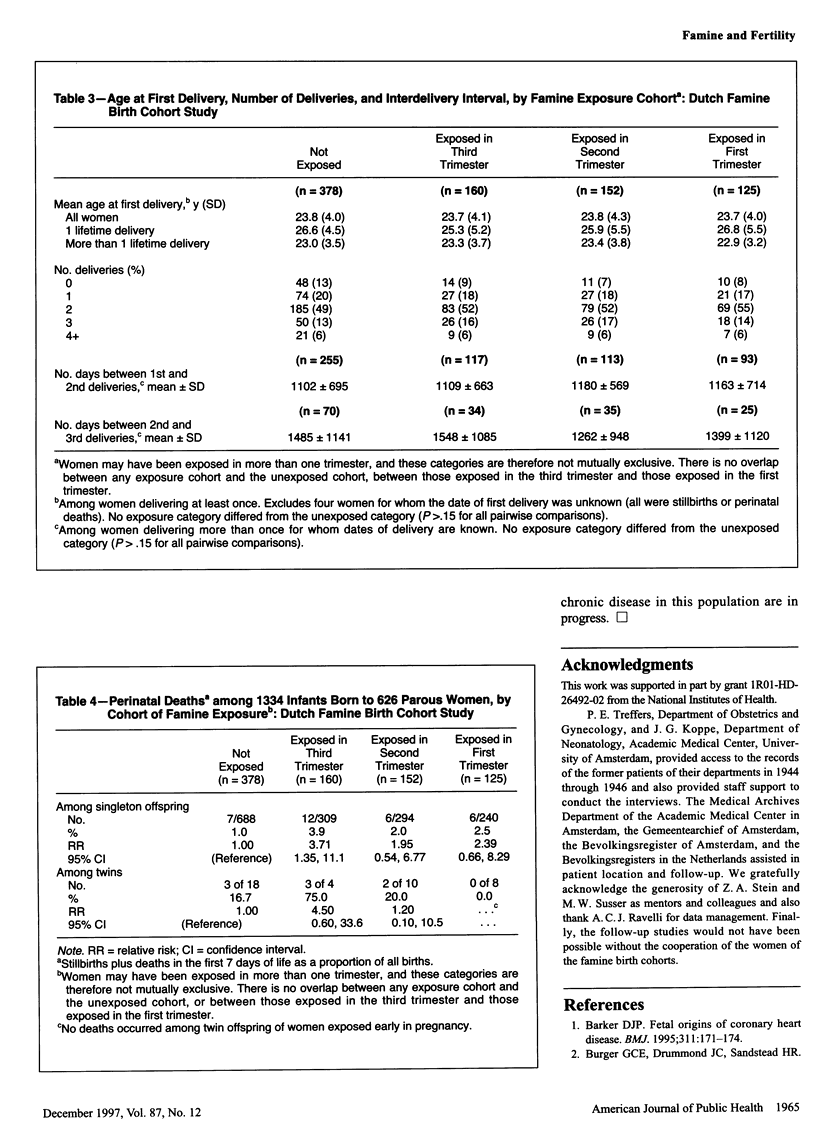Abstract
OBJECTIVES: We hypothesized that if prenatal caloric restriction due to nutritional deprivation had affected development of the organs responsible for producing and regulating female reproductive hormones, a woman's fertility would be impaired. METHODS: Women born in Amsterdam from August 1, 1944, through April 15, 1946, a period encompassing a severe 5-month famine, were identified (n = 700; 85% response rate). Date of birth and vital status of all offspring were ascertained by home interview between 1987 and 1991. Famine exposure was inferred from the mother's date of birth. RESULTS: Of the study participants, 74 (10.6%) had no children. The remainder reported 1334 off-spring (1294 singletons, 20 pairs of twins), of whom 14 were stillborn and 22 died in the first 7 days of life. There was no detectable effect of famine exposure on age at menarche, the proportion having no children, age at first delivery, or family size. An excess of perinatal deaths occurred among offspring of famine-exposed women, particularly those exposed in their third trimester. CONCLUSIONS: Acute famine exposure in utero appears to have no adverse consequences for a woman's fertility. The excess perinatal mortality in the second generation is unexplained and should be confirmed by other studies.
Full text
PDF




Selected References
These references are in PubMed. This may not be the complete list of references from this article.
- Barker D. J. Fetal origins of coronary heart disease. BMJ. 1995 Jul 15;311(6998):171–174. doi: 10.1136/bmj.311.6998.171. [DOI] [PMC free article] [PubMed] [Google Scholar]
- Lumey L. H., Ravelli A. C., Wiessing L. G., Koppe J. G., Treffers P. E., Stein Z. A. The Dutch famine birth cohort study: design, validation of exposure, and selected characteristics of subjects after 43 years follow-up. Paediatr Perinat Epidemiol. 1993 Oct;7(4):354–367. doi: 10.1111/j.1365-3016.1993.tb00415.x. [DOI] [PubMed] [Google Scholar]
- Lumey L. H., Van Poppel F. W. The Dutch famine of 1944-45: mortality and morbidity in past and present generations. Soc Hist Med. 1994 Aug;7(2):229–246. doi: 10.1093/shm/7.2.229. [DOI] [PubMed] [Google Scholar]
- SINDRAM I. S. De invloed van ondervoeding op de groei van de vrucht. Ned Tijdschr Verloskd Gynaecol. 1953;53(1):30–48. [PubMed] [Google Scholar]
- Stein A. D., Ravelli A. C., Lumey L. H. Famine, third-trimester pregnancy weight gain, and intrauterine growth: the Dutch Famine Birth Cohort Study. Hum Biol. 1995 Feb;67(1):135–150. [PubMed] [Google Scholar]


